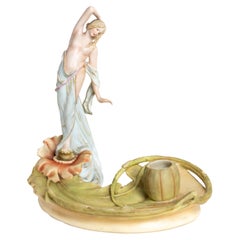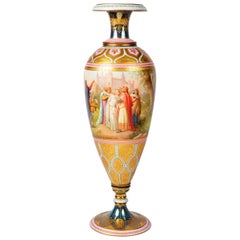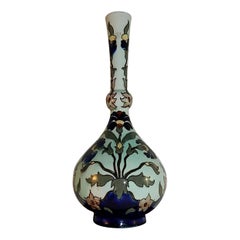Beauvais Royal Manufactory Decorative Objects
to
1
1
1
1
1
1
1
1
1
Height
to
Width
to
1
1
1
5
1,351
747
489
478
Creator: Beauvais Royal Manufactory
Art Nouveau Porcelain Inkwell With Venus and Water Lily, 19th Century
By Beauvais Royal Manufactory
Located in Lisbon, PT
This 19th century porcelain inkwell features a graceful figure of Venus rising from a water lily.
Created by Alois Hampel and marked “3359”, this piece was produced by the renowned ...
Category
19th Century Czech Art Nouveau Antique Beauvais Royal Manufactory Decorative Objects
Materials
Porcelain
$2,184 Sale Price
20% Off
Related Items
19th Century Vienna Porcelain Vase
By Imperial Vienna Porcelain
Located in Brighton, Sussex
A very good quality 19th century Vienna porcelain vase, depicting classical scenes and gilded borders.
Category
19th Century Austrian Antique Beauvais Royal Manufactory Decorative Objects
Materials
Porcelain
Rozenburg DenHaag Art Nouveau Vase, Late 19th Century
By Rozenburg Porcelain
Located in Phoenix, AZ
Rozenburg earthenware vase, Holland, circa 1890s.
Polychrome enameled with stylized flowers.
Painted mark: Rozenburg denHaag K522 and the stork symbol.
Measures: 8.63" H x 4" W. Mint condition.
The Rozenburg Royal Delftware...
Category
Late 19th Century European Art Nouveau Antique Beauvais Royal Manufactory Decorative Objects
Materials
Clay
19th Century French Art Nouveau Stoneware Cider Pitcher with Satyr Handle
Located in Haarlem, NL
Large 19th century Art Nouveau stoneware cider pitcher with a detailed satyr, faun or devil hanging on a tree branche handle.
Unfortunately I know nothin...
Category
Late 19th Century French Art Nouveau Antique Beauvais Royal Manufactory Decorative Objects
Materials
Stoneware
$680 Sale Price
20% Off
H 12.6 in W 8.27 in D 6.3 in
Carlsbad Austrian Art Nouveau Porcelain Iridesecent Vase, Late 19th Century
By Carlsbad, Loetz Glass
Located in South Bend, IN
A gorgeous Art Nouveau period iridescent porcelain vase
In the manner of Loetz
By Carlsbad Porcelain
Austria, Late 19th Century
Measures: 4.5"W x 4.5"D x 8.5"H.
Very good origin...
Category
Late 19th Century Austrian Art Nouveau Antique Beauvais Royal Manufactory Decorative Objects
Materials
Porcelain
$1,995
H 8.5 in W 4.5 in D 4.5 in
Art Nouveau Water Lily Vase Jugendstil Bronze in the Manner of Otto Eckman
By Otto Eckmann
Located in Miami, FL
Jugendstil ceramic vase bronze mounted is an original decorative object realized in the early 20th century.
Original ceramic vase with cream and cobalt blue glaze. All around colorf...
Category
Early 19th Century German Jugendstil Antique Beauvais Royal Manufactory Decorative Objects
Materials
Bronze
$6,890
H 28.34 in W 18.11 in D 18.11 in
19th Century Meissen Porcelain 'Elements' Ewer Emblematic of Water
By Meissen Porcelain
Located in New York, NY
A 19th century Meissen porcelain 'Elements' ewer emblematic of water. Blue crossed swords mark. The present ewer, representing water,...
Category
1870s German Rococo Antique Beauvais Royal Manufactory Decorative Objects
Materials
Porcelain
Paris Porcelain Vase 19th Century
By Porcelaine de Paris
Located in LA CIOTAT, FR
This very pretty Paris porcelain vase dates from the 19th century, and features a beautiful enamelled floral design of wildflowers, surrounded by rococo style moulding embellished wi...
Category
19th Century French Napoleon III Antique Beauvais Royal Manufactory Decorative Objects
Materials
Porcelain
Bohemian Czech Art Nouveau Art Glass Inkwell with Water Lily Overlay
By Loetz Glass
Located in San Diego, CA
Stunning Bohemian Czech Art Nouveau inkwell with metal water lily overlay in the style of Loetz, circa 1900s. The green art glass well is capped with...
Category
Early 20th Century Czech Art Nouveau Beauvais Royal Manufactory Decorative Objects
Materials
Metal, Brass
$425 Sale Price
34% Off
H 2.75 in Dm 2.75 in
19th Century Country French Fountain with Porcelain Reservoir and Basin
Located in Dallas, TX
19th century Country French fountain with porcelain reservoir and basin is a charming ode to a bygone era! Back before hot and cold running water, it was desirable for family members...
Category
Early 19th Century French French Provincial Antique Beauvais Royal Manufactory Decorative Objects
Materials
Porcelain, Oak
$1,850
H 68 in W 21.5 in D 15 in
Late 19th Century Faux Royal Vienna Art Nouveau Vases
Located in Chapel Hill, NC
A pair of Art Nouveau vases, faux-Royal Vienna. decorated with romantic transfer print reserves. Made in Austria, c.1895-1910. 10 1/2" h., 4 1/2" over handles.
We have been a majo...
Category
Late 19th Century Austrian Art Nouveau Antique Beauvais Royal Manufactory Decorative Objects
Materials
Ceramic
$175 Sale Price / set
40% Off
H 10.5 in Dm 4.5 in
French Soliflor Vase in White and Blue Opaline Art Nouveau - 19th
Located in Beuzevillette, FR
Vase in white and blue opaline glass. Traces of gilding on the neck and trunk.
France.
Late 19th century. Art Nouveau
Opaline or opaline glass is a type of white or colored, opaque o...
Category
Late 19th Century French Art Nouveau Antique Beauvais Royal Manufactory Decorative Objects
Materials
Opaline Glass
Art Nouveau Crystal and Gilt Brass Bottle with Stopper 19th Century
Located in LA CIOTAT, FR
A pretty crystal, stoppered bottle, intricately clad in an openwork gilt-brass motif of entwined poppies and mistletoe. This square-sided Art Nouveau period bottle features a simple,...
Category
Late 19th Century French Empire Antique Beauvais Royal Manufactory Decorative Objects
Materials
Crystal, Brass
$1,300
H 5.71 in W 3.35 in D 3.35 in
Beauvais Royal Manufactory decorative objects for sale on 1stDibs.
Beauvais Royal Manufactory decorative objects are available for sale on 1stDibs. These distinctive items are frequently made of porcelain and are designed with extraordinary care. Many of the original decorative objects by Beauvais Royal Manufactory were created in the Art Nouveau style in europe during the 19th century. If you’re looking for additional options, many customers also consider decorative objects by Wilhelm Kralik Sohn, Koloman Moser, and Wilhelm Schiller & Son. Prices for Beauvais Royal Manufactory decorative objects can differ depending upon size, time period and other attributes — on 1stDibs, these items begin at $3,607 and can go as high as $3,607, while a piece like these, on average, fetch $3,607.


